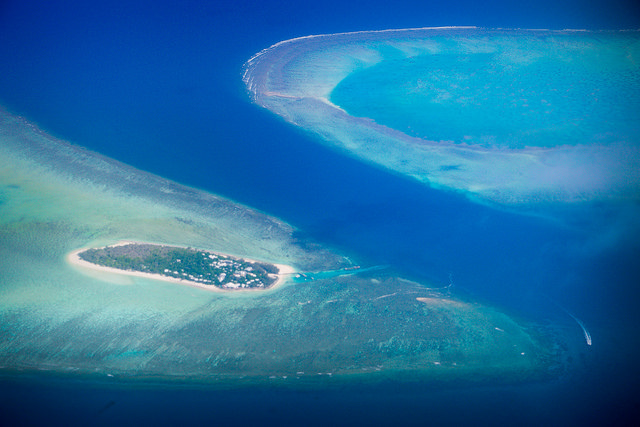World’s largest coral reef system, the Great Barrier Reef, remains on the United Nations World Heritage list after a United Nations Educational, Scientific and Cultural organization (UNESCO) issued its draft decision this week, declaring the reef as not “in danger”.
The draft decision acknowledges the strong response of the Australian and Queensland governments as outlined in the Reef 2050 Long-term Sustainability Plan, specifically in the management of the reef such as:
- restoring water quality, including the objective of an 80% reduction in pollution run-off in the property by 2015;
- additional investment of $Aus 200 million to accelerate progress in its investment strategy;
- restricting major new port development in and adjoining the Great Barrier Reef World Heritage Area, by limiting capital dredging for the development or new or expansion of existing port facilities to within the regulated port limits of the four major ports of Gladstone, Hay Point/Mackay, Abbot Point and Townsville;
- commitment for a permanent ban on dumping of dredged material from all capital dredging projects;
- the 5-year GBR Outlook Report are expected to provide the basis for evaluating the plans performance, the results achieved towards the restoration od degraded areas, the protection of the reef’s Outstanding Universal Value and its resilience to the effects of climate change.
The Australian and Queensland governments, on the other hand, welcome the Great Barrier Reef draft decision for the World Heritage Committee’s consideration.
The draft decision is a reflection of our strong and decisive actions to protect the iconic Great Barrier Reef and our significant work to address all of the Committee’s concerns, the governments said in a statement. “The World Heritage Committee acknowledges the strong response that Australia and Queensland have put in place through the development and implementation of the recently released Reef 2050 Long term Sustainability Plan.”
“ We have listened intently and responded directly to the concerns from the Australian community, the World Heritage Committee and their technical advisors,” it added.
The draft decision also adopts Australia’s proposal that the next State of Conservation Report be provided in 2020, which will be based on the scientifically robust and independent 2019 Outlook Report undertaken by the Great Barrier Reef Marine Park Authority.
The IUCN and World Heritage Centre recognize that the ordinary five yearly reporting timeframe is appropriate to assess the implementation of LTSP and Australia’s considerable efforts.
We have also proposed, and the draft decision recommends, that Australia provide an update on progress in implementing the Reef 2050 Plan in 2017, Australian government said.
“ We have valued greatly the opportunity to work closely with the technical advisors to the Committee from the World Heritage Centre and the IUCN, in order to realize our strong further actions to protect the reef. We will continue to engage closely with the World Heritage Committee,” it said.
Australia is already turning to the important job of implementing the Reef 2050 Plan including through prioritizing our investment, ensuring continued scientific and community input on the management of the reef, as well as improving our monitoring efforts.
Ministers Hunt, Miles and Deputy Premier Jackie Trad will represent Australia at the World Heritage Committee meeting in Bonn, Germany at the end of June where a final decision on the status of the Great Barrier Reef will be made.
The UNESCO draft decision further notes the conclusion of the 2014 Great Barrier Reef Outlook Report that the overall Outlook of reef is “ poor, and that climate change, poor water quality and impacts from coastal development are major threats to the property’s health and regrets that key habitats, species and ecosystem processes in the central and southern inshore areas have continued to deteriorate from the cumulative effects of these impacts.”
It however, welcomed the efforts of the Australian government as mentioned in the Reef 2050 Long-Term Sustainability Plan that outlines an overarching vision for the future conservation of the property over the next 35 years.
Australia regards the Reef as an important natural icon. The Reef is vitally important to communities and industries that depend on a healthy reef for recreation and their livelihoods, said Russell Reichelt, Administrator of the Great Barrier Reef Marine Park Authority.
Reichelt said that while the Reef is under pressure, the government “is responding to the challenge of improving its health through its overarching long-term sustainability plan.”
Environmental activists Greenpeace earlier clamored that the Australian government’s support of planned coal port expansions – which would lead to more coal ships travelling through the Great Barrier Reef and more dredging – will have direct individual and cumulative impacts on the Reef, one of the world’s natural wonders.
“Rather than doing everything it can to save the Great Barrier Reef, the government is aggressively promoting coal port expansion, which poses direct threats to the Reef and will drive climate change. The coal expansion plans, including the Adani coal mine, are irreconcilable with the government’s international responsibility to protect the Reef and should be abandoned,”Greenpeace Australia campaigner Jessica Panegyres said.

“Port expansions and increased shipping negatively affect coral, seagrass, dugongs, turtles and other marine life – species that make the Great Barrier Reef a natural wonder,” she said.
The health of the Great Barrier Reef is already in decline – 50% of the Reef’s coral cover has disappeared in the past 30 years. Greenpeace said Australia should be doing everything possible to restore the Reef’s health and unless the government markedly steps up its conservation efforts, including rejecting coal and port expansion plans, it will not have avoided the need for an ‘in danger’ listing.
The Reef is a priceless natural asset for the world. But for the Australians, it’s much more than this. It was a stage for important events in our nation’s history, and today its incomparable natural beauty feeds our national pride, said Department of Environment Secretary Gordon de Brouwer.
“ This is why the Australian community is united in insisting on its conservation, and this is why Australian governments, both at the national and state level, are so firmly committed to its protection,” de Brouwer said.
photos by DFAT/Patrick Hamilton
story by Imelda Abano

